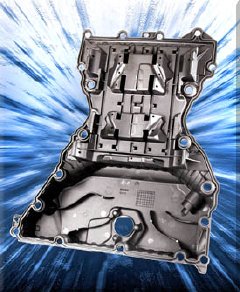Dec 28 2008
The Society of Plastics Engineers’ (SPE) automotive division recently honored two automotive components that use DuPont engineering polymers with the association’s 2008 “Most Innovative Use of Plastics” awards.
 An oil pan module.
An oil pan module.
Daimler was given top honors in the powertrain/chassis category for the world’s first commercial volume polymer oil pan module, which was developed with Bruss and DuPont Automotive using DuPont™ Zytel® nylon. Ford was named a finalist in the powertrain/chassis category for an innovative “capless” fuel filler system for the 2008 Ford Flex, Escape, F150, Expedition and Lincoln MKS vehicles. The new fuel filler system was developed with Martinrea and DuPont Automotive using DuPont™ Zytel® HTN PPA.
The oil pan, which powers Mercedes-Benz C Class vehicles, consists of a die-cast aluminium upper shell and a multifunctional lower shell, reducing overall weight by a significant 1.1 kilograms (vs. an all-aluminium design) for fuel savings and lower CO2 emissions.
The Ford “capless” fuel filler system is being enjoyed by consumers who dislike the refueling process. It also is compatible with biofuels and supports the compliance of Ford’s vehicles to all California low emission vehicle requirements. This system could further reduce emissions relative to capped systems because the fuel neck is not opened until the fuel pump nozzle is inserted. When capless fueling is completed, the nozzle is removed and the system seals shut automatically, helping to minimize evaporative emissions.
“The challenge to reduce weight for fuel savings and emissions reductions drives many companies to rethink the design and manufacture of system components,” said Karla Butler, marketing and development director, DuPont Automotive Performance Materials, Americas. “Automakers are looking for new materials and technology to help improve fuel efficiency and reduce emissions without compromising system performance. The science and R&D capabilities of DuPont help enable collaboration that can bring these new developments to market faster and more cost-effectively.”